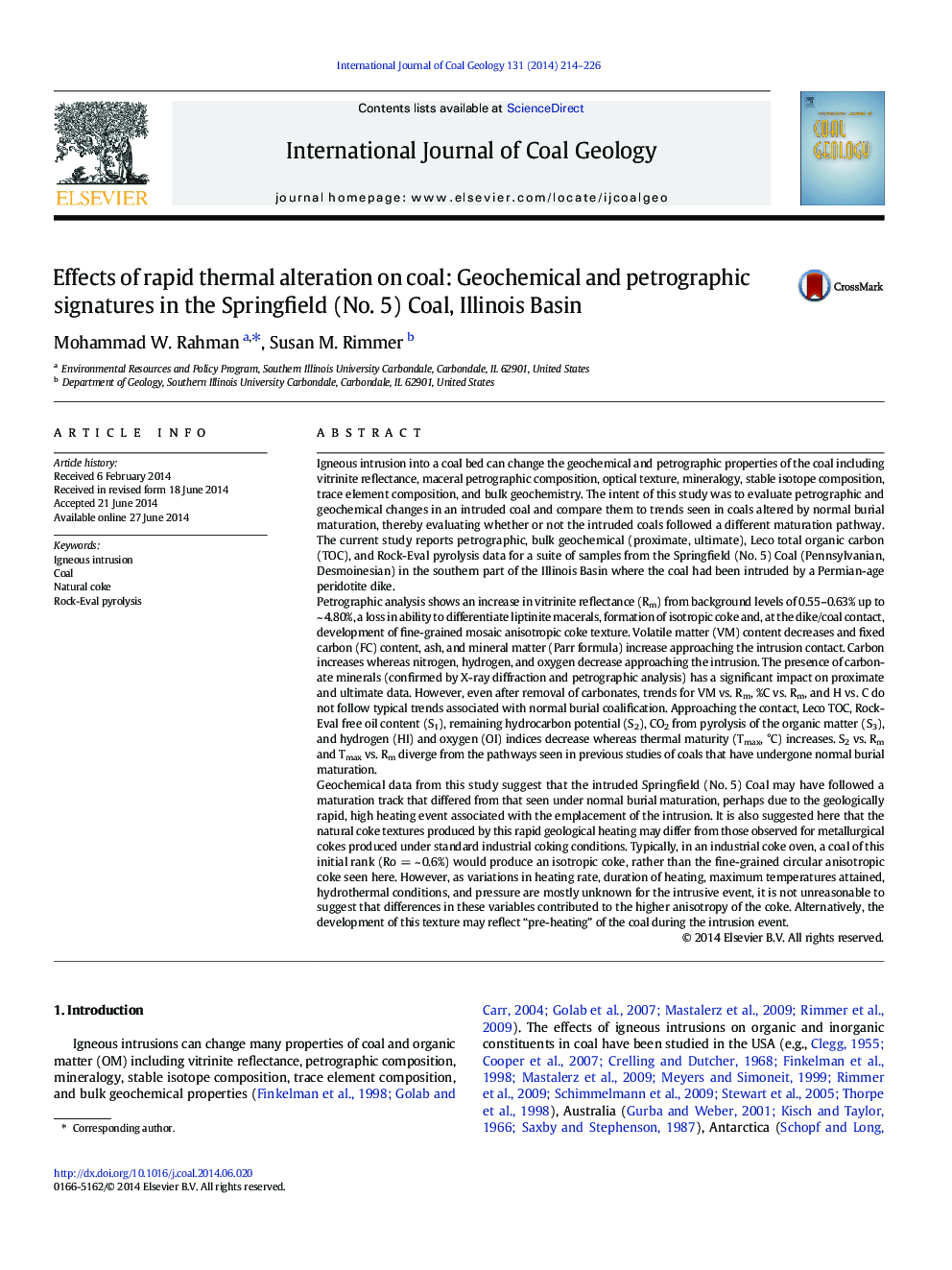| کد مقاله | کد نشریه | سال انتشار | مقاله انگلیسی | نسخه تمام متن |
|---|---|---|---|---|
| 1753027 | 1522566 | 2014 | 13 صفحه PDF | دانلود رایگان |
• Petrographic and geochemical data are presented for an intruded coal
• Rm, VM, TOC, S1, S2, S3, HI, OI decrease and FC, Tmax, ash increase towards dike
• Relationships do not always follow trends seen under burial maturation
• Coke texture close to dike is more anisotropic than expected for background rank
• Differences in heating rate, duration, temperature, pressure influence maturation
Igneous intrusion into a coal bed can change the geochemical and petrographic properties of the coal including vitrinite reflectance, maceral petrographic composition, optical texture, mineralogy, stable isotope composition, trace element composition, and bulk geochemistry. The intent of this study was to evaluate petrographic and geochemical changes in an intruded coal and compare them to trends seen in coals altered by normal burial maturation, thereby evaluating whether or not the intruded coals followed a different maturation pathway. The current study reports petrographic, bulk geochemical (proximate, ultimate), Leco total organic carbon (TOC), and Rock-Eval pyrolysis data for a suite of samples from the Springfield (No. 5) Coal (Pennsylvanian, Desmoinesian) in the southern part of the Illinois Basin where the coal had been intruded by a Permian-age peridotite dike.Petrographic analysis shows an increase in vitrinite reflectance (Rm) from background levels of 0.55–0.63% up to ~ 4.80%, a loss in ability to differentiate liptinite macerals, formation of isotropic coke and, at the dike/coal contact, development of fine-grained mosaic anisotropic coke texture. Volatile matter (VM) content decreases and fixed carbon (FC) content, ash, and mineral matter (Parr formula) increase approaching the intrusion contact. Carbon increases whereas nitrogen, hydrogen, and oxygen decrease approaching the intrusion. The presence of carbonate minerals (confirmed by X-ray diffraction and petrographic analysis) has a significant impact on proximate and ultimate data. However, even after removal of carbonates, trends for VM vs. Rm, %C vs. Rm, and H vs. C do not follow typical trends associated with normal burial coalification. Approaching the contact, Leco TOC, Rock-Eval free oil content (S1), remaining hydrocarbon potential (S2), CO2 from pyrolysis of the organic matter (S3), and hydrogen (HI) and oxygen (OI) indices decrease whereas thermal maturity (Tmax, °C) increases. S2 vs. Rm and Tmax vs. Rm diverge from the pathways seen in previous studies of coals that have undergone normal burial maturation.Geochemical data from this study suggest that the intruded Springfield (No. 5) Coal may have followed a maturation track that differed from that seen under normal burial maturation, perhaps due to the geologically rapid, high heating event associated with the emplacement of the intrusion. It is also suggested here that the natural coke textures produced by this rapid geological heating may differ from those observed for metallurgical cokes produced under standard industrial coking conditions. Typically, in an industrial coke oven, a coal of this initial rank (Ro = ~ 0.6%) would produce an isotropic coke, rather than the fine-grained circular anisotropic coke seen here. However, as variations in heating rate, duration of heating, maximum temperatures attained, hydrothermal conditions, and pressure are mostly unknown for the intrusive event, it is not unreasonable to suggest that differences in these variables contributed to the higher anisotropy of the coke. Alternatively, the development of this texture may reflect “pre-heating” of the coal during the intrusion event.
Journal: International Journal of Coal Geology - Volume 131, 1 September 2014, Pages 214–226
